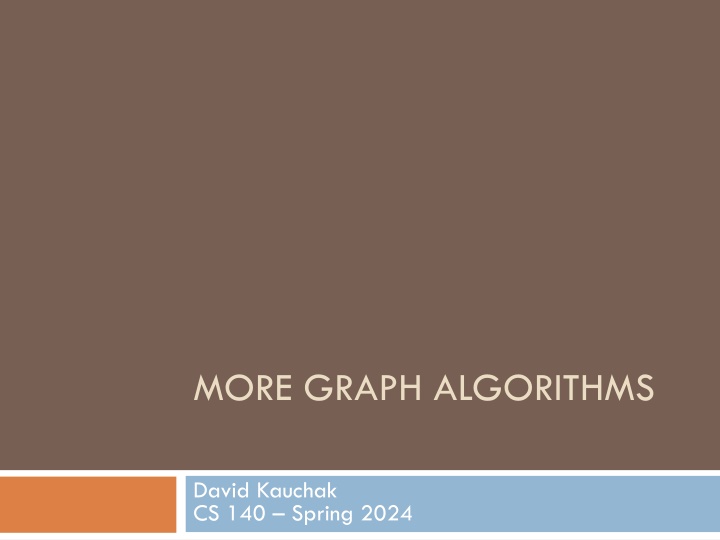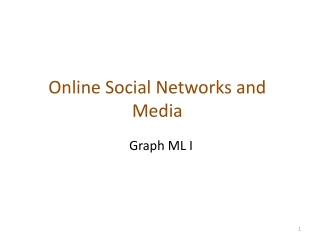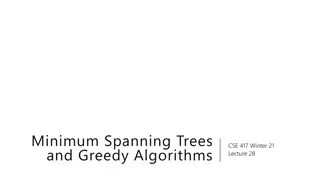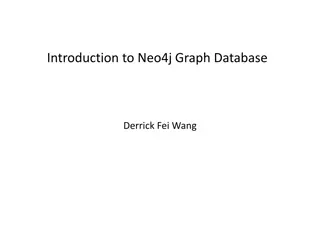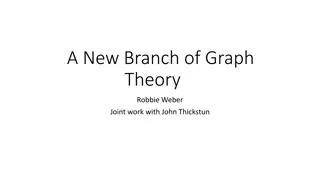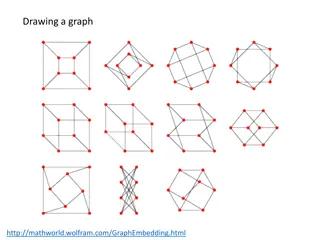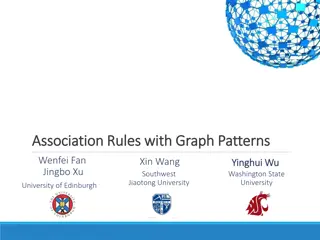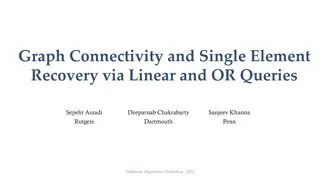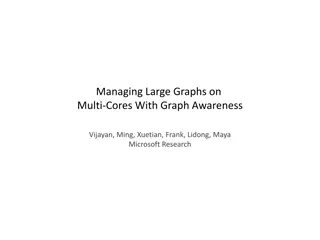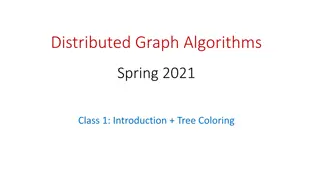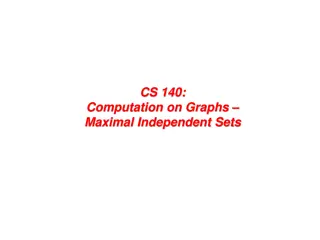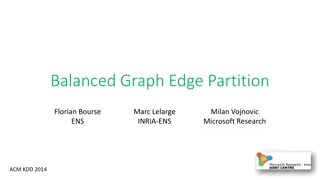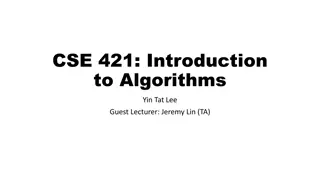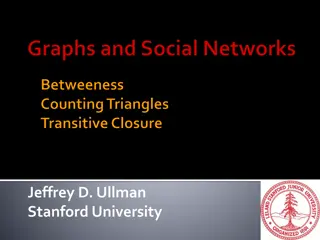MORE GRAPH ALGORITHMS
This content covers various graph algorithms such as connectedness, strongly connected, transpose of a graph, runtime analysis, and minimum spanning trees. It explains how these algorithms work, their significance, and the runtime complexities associated with them. The content also delves into the concept of minimum spanning trees, exploring their definition and related algorithms.
Uploaded on Feb 20, 2025 | 2 Views
Download Presentation

Please find below an Image/Link to download the presentation.
The content on the website is provided AS IS for your information and personal use only. It may not be sold, licensed, or shared on other websites without obtaining consent from the author.If you encounter any issues during the download, it is possible that the publisher has removed the file from their server.
You are allowed to download the files provided on this website for personal or commercial use, subject to the condition that they are used lawfully. All files are the property of their respective owners.
The content on the website is provided AS IS for your information and personal use only. It may not be sold, licensed, or shared on other websites without obtaining consent from the author.
E N D
Presentation Transcript
MORE GRAPH ALGORITHMS David Kauchak CS 140 Spring 2024
Admin Assignment 8 out: don t reinvent the wheel Assignment schedule updated for the rest of the semester Groups optional this week
Connectedness Given an undirected graph, for every node u V, can we reach all other nodes in the graph? Algorithm + running time Run BFS or DFS-Visit (one pass) and mark nodes as we visit them. If we visit all nodes, return true, otherwise false. Running time: O(|V| + |E|)
Strongly connected Given a directed graph, can we reach any node v from any other node u? Can we do the same thing?
Transpose of a graph Given a graph G, we can calculate the transpose of a graph GR by reversing the direction of all the edges GR G A A B B D D E E C C Running time to calculate GR? (|V| + |E|)
Strongly connected Strongly-Connected(G) - Run DFS-Visit or BFS from some node u - If not all nodes are visited: return false - Create graph GR - Run DFS-Visit or BFS on GR from node u - If not all nodes are visited: return false - return true
Is it correct? What do we know after the first pass? Starting at u, we can reach every node What do we know after the second pass? All nodes can reach u. Why? We can get from u to every node in GR, therefore, if we reverse the edges (i.e. G), then we have a path from every node to u Which means that any node can reach any other node. Given any two nodes s and t we can create a path through u s u t
Runtime? Strongly-Connected(G) - Run DFS-Visit or BFS from some node u - If not all nodes are visited: return false - Create graph GR - Run DFS-Visit or BFS on GR from node u - If not all nodes are visited: return false - return true O(|V| + |E|) O(|V|) (|V| + |E|) O(|V| + |E|) O(|V|) O(|V| + |E|)
Minimum spanning trees What are they? What do you remember about them? What algorithms do you remember?
Minimum spanning trees What is the lowest weight set of edges that connects all vertices of an undirected graph with positive weights Input: An undirected, positive weight graph, G=(V,E) Output: A tree T=(V,E ) where E E that minimizes e = ( ) weight T w e ' E
MST example 1 A C E 3 4 4 2 5 4 B D F 4 6 1 A C E 4 2 5 4 B D F
MSTs Can an MST have a cycle? 1 A C E 4 2 5 4 B D F 4
MSTs Can an MST have a cycle? 1 A C E 4 2 5 4 B D F
Applications? Connectivity Networks (e.g. communications) Circuit design/wiring hub/spoke models (e.g. flights, transportation) Traveling salesman problem?
Algorithm ideas? 1 A C E 3 4 4 2 5 4 B D F 4 6 1 A C E 4 2 5 4 B D F
Cuts A cut is a partitioning of the vertices into two sets S and V-S An edge crosses the cut if it connects a vertex u V and v V-S 1 A C E 3 4 4 2 5 4 B D F 4 6
Minimum cut property Given a partition S, let edge e be the minimum cost edge that crosses the partition. Every minimum spanning tree contains edge e. Proof by contradiction? 1 A C E 3 4 4 2 5 4 B D F 4 6
Minimum cut property Given a partition S, let edge e be the minimum cost edge that crosses the partition. Every minimum spanning tree contains edge e. S V-S e e Consider an MST with edge e that is not the minimum edge
Minimum cut property Given a partition S, let edge e be the minimum cost edge that crosses the partition. Every minimum spanning tree contains edge e. S V-S e e Using e instead of e , still connects the graph, but produces a tree with smaller weights
Minimum cut property If the minimum cost edge that crosses the partition is not unique, then some minimum spanning tree contains edge e. 1 A C E 3 4 4 2 5 4 B D F 4 6
Kruskals algorithm Given a partition S, let edge e be the minimum cost edge that crosses the partition. Every minimum spanning tree contains edge e.
Add smallest edge that connects two sets not already connected Kruskal s algorithm 1 A C E 3 5 4 4 3 4 MST B D F 2 6 A C E G B D F
Add smallest edge that connects two sets not already connected Kruskal s algorithm 1 A C E 3 5 4 4 3 4 MST B D F 2 6 A C E G B D F
Add smallest edge that connects two sets not already connected Kruskal s algorithm 1 A C E 3 5 4 4 3 4 MST B D F 1 2 6 A C E G B D F
Add smallest edge that connects two sets not already connected Kruskal s algorithm 1 A C E 3 5 4 4 3 4 MST B D F 1 2 6 A C E G B D F
Add smallest edge that connects two sets not already connected Kruskal s algorithm 1 A C E 3 5 4 4 3 4 MST B D F 1 2 6 A C E G 2 B D F
Add smallest edge that connects two sets not already connected Kruskal s algorithm 1 A C E 3 5 4 4 3 4 MST B D F 1 2 6 A C E G 2 B D F
Add smallest edge that connects two sets not already connected Kruskal s algorithm 1 A C E 3 5 4 4 3 4 MST B D F 1 2 6 A C E G 3 2 B D F
Add smallest edge that connects two sets not already connected Kruskal s algorithm 1 A C E 3 5 4 4 3 4 MST B D F 1 2 6 A C E G 3 2 B D F
Add smallest edge that connects two sets not already connected Kruskal s algorithm 1 A C E 3 5 4 4 3 4 MST B D F 1 2 6 A C E G 4 3 2 B D F
Add smallest edge that connects two sets not already connected Kruskal s algorithm 1 A C E 3 5 4 4 3 4 MST B D F 1 2 6 A C E G 4 3 2 B D F
Add smallest edge that connects two sets not already connected Kruskal s algorithm 1 A C E 3 5 4 4 3 4 MST B D F 1 2 6 A C E G 5 4 3 2 B D F
Add smallest edge that connects two sets not already connected Kruskal s algorithm 1 A C E 3 5 4 4 3 4 MST B D F 1 2 6 A C E G 5 4 3 2 B D F
Add smallest edge that connects two sets not already connected Kruskal s algorithm 1 A C E 3 5 4 4 3 4 MST B D F 1 2 6 A C E G 5 4 3 2 Done! B D F
Correctness of Kruskals Never adds an edge that connects already connected vertices Always adds lowest cost edge to connect two sets. By min cut property, that edge must be part of the MST
Running time of Kruskals |V| calls to MakeSet O(|E| log |E|) 2 |E| calls to FindSet |V| calls to Union
Disjoint set data structures Represents a collection of one or more sets Operations: - MakeSet: Add a new value to the collections and make the value it s own set - FindSet: Given a value, return the set the value is in - Union: Merge two sets into a single set
Disjoint set data structure MakeSet(A), MakeSet(B), MakeSet(C), MakeSet(D), MakeSet(E) Disjoint Set A B C D E
Disjoint set data structure FindSet(A)? Disjoint Set A B C D E
Disjoint set data structure FindSet(A)? Disjoint Set A B C D E
Disjoint set data structure Union(FindSet(A), FindSet(E)) Disjoint Set A B C D E
Disjoint set data structure Union(FindSet(A), FindSet(E)) Disjoint Set A B C D E
Disjoint set data structure Union(FindSet(C), FindSet(D)) Disjoint Set A B C D E
Disjoint set data structure Union(FindSet(C), FindSet(D)) Disjoint Set A B C E D
Disjoint set data structure FindSet(D)? Disjoint Set A B C E D
Disjoint set data structure FindSet(D)? Disjoint Set A B C E D
Disjoint set data structure Union(FindSet(D), FindSet(B)) Disjoint Set A B C E D
Disjoint set data structure Union(FindSet(D), FindSet(B)) Disjoint Set B A E C D
Disjoint set data structure How would we implement it with a list of linked lists? MakeSet? FindSet? Union? Disjoint Set B A E C D
